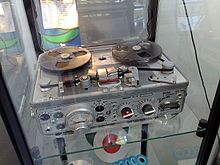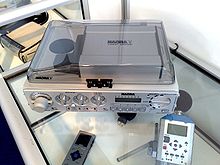- Nagra
-
For the cable and satellite conditional access system, see Nagravision.
Nagra is the trademark referring to any of the series of mostly battery-operated portable professional audio recorders produced by Kudelski SA, based in Cheseaux-sur-Lausanne, Switzerland.
The machines were initially designed by Polish inventor Stefan Kudelski, and his company won numerous technical awards for their precision and reliability.
Contents
History
Nagra-brand tape recorders were the de facto standard sound recording systems for motion picture and single-camera television production from the 1960s until the 1990s. Their physical appearance, with the single transport selector and large reel-to-reel tape deck are still the stereotypical image most people have of a professional tape recorder. A Nagra IV-S recorder prominently appears in the 1981 movie Diva, which features an opera fan making field recordings of his favorite opera singer; another Nagra (a Nagra III) features prominently in the 1981 John Travolta film Blow Out about a freelance sound effects engineer. Another Nagra III may be seen in the Beatles' movie Help!. In the film The Informant! the FBI installs a Nagra in Matt Damon's character's briefcase to covertly record conversations related to ADM price fixing. A Nagra SN is featured in the 1974 psychological thriller The Conversation.
The word "nagra" comes from Stefan Kudelski's mother tongue Polish word "nagrać" and stands for "to record" or from the Polish phrase "nagra", which stands for "will record".
The analogue Nagra recorders have a reputation for extreme ruggedness and reliability, essentially being the "Swiss watch" of audio tape recorders. Their cases are highly durable, and every component, from the transport rollers to the gain pots, have the feel of excellent engineering. The feature that gave Nagra the edge in quality and film use was Stefan Kudelski's development of the Neo-Pilottone system, where synchronization data could be recorded on the tape in the middle of the audio track, but without crosstalk onto the program recording.
Kudelski SA defines Neopilot as follows: "Full track monophonic recorders (Nagra models III, E, IV and 4.2) use a patented system in order to control the speed of the NAGRA during playback to ensure it turns at the exact same speed as the reference (Projector / Camera / Perfo-tape machine). The frequency of the pilot signal is typically 50 Hz when filming at 25 fps and 60 when filming at 24 fps. The reference standard was originally derived from studio lot power line "mains" or when on location from manually controlled motor/generator sets, until the development of accurate crystal controlled sync signal generators. The Neopilot sync record head is physically located after the record and playback heads on the tape path. The sync track is recorded down the center of the tape. The head is constructed in such a manner that it creates two very narrow parallel tracks which the signal to each is applied 180 degrees out of phase with the other. The result of this is that it can be picked up by the sync head during playback but is canceled out when running across the mono audio playback head. The start point of a take is marked by an audible clap recorded on tape and the visual meeting of the "sticks" on the film clapper board and the synchronization to the magnetic film is maintained using the pilot signal throughout the take."
Commercial motion pictures were traditionally filmed using a dual system, that is picture on photographic film in the camera, and sound on a magnetic tape recorder. Neopilot was the standard synchronization system used to synchronize these separate elements until the late 1980s, when timecode became the preferred standard. Nagra used a special, very narrow timecode track in between the space of channel 1 and channel 2 on the stereo Nagra IV-S and T models. The advantage of timecode over Pilottone is that timecode encodes positional information (essentially time-of-day) with respect picture in addition to the simple speed information encoded by the earlier Pilottone system, thus greatly improving the identification of picture and sound takes. The timecode information is utilized by visual timecode slating systems, like the award winning Denecke model commonly used by major studios; similar slates were also manufactured by companies like Ambient of Germany and PSC of Valencia, California. By the mid-1990s, the use of analog 1/4" tape began to transition to DAT, which also used time code. By the mid-2000s, the industry trend was firmly set to non-linear recorders, such as Zaxcom's Deva and Aaton Cantar systems, along with lower-cost recorders from Sound Devices.
Although digital recording is now the norm for most dialog recording in motion pictures and television series, sound effects recordists still use analog Nagra tape recorders for certain kinds of background sounds, particularly explosions, gunshots, and other loud sounds of extreme dynamic range. Engineers advise that while digital recording is technically more accurate, analog tape recording still has the edge in terms of being able to handle unexpected signal overloads.
Models
Nagra recorders are identified by their model number, which indicates their technological generation and features:
- NAGRA I - The very first prototype with clockwork motor and miniature tubes, appearing in 1951. Two were sold to Radio Genève.
- NAGRA II - The first production model, miniature tubes equipped, clockwork motor, appearing in 1953.
- NAGRA II CI - The second generation fitted with printed circuit boards replacing chassis wiring, appearing in 1955.
- Nagra III NP - The first Nagra usable for film work, appearing in 1961. Monaural, Neopilot sync
- Nagra IV-L - Monaural, Neopilot sync, featuring two microphone inputs and a built in audio limiter. Introduced in 1968.
- Nagra 4.2 - Same as the IV-L, but added powering for microphones and built-in equalizers. Introduced in 1972. In the '80s one could upgrade a 4.2 to record SMPTE timecode.
- Nagra IV-S - Stereo Nagra, recording two-track stereo. It had dual level pots, limiters, and equalizer presets. It was introduced in 1971. It originally employed a 14kHz sync signal that is not compatible with the earlier Neopilot sync. This signal is recorded employing FM modulation on a third or center track that could simultaneously be employed as an additional but lower quality "cue" track. In 1984 Nagra introduced timecode support. With timecode support an IV-S became a Nagra IV-STC.
- Nagra IV-SJ - Stereo Nagra for instrumentation and logging. Pots are replaced with switches to set gain in precise steps, no limiters, and when present, the microphone inputs are for high-voltage unbalanced instrumentation mics rather than low impedance balanced with T-power and phantom.
- NAGRA E - A simple, single-speed (7.5ips), mono recorder aimed at radio reporters was introduced in 1976.
In addition to these field recorders, Kudelski S.A. produced a studio recorder called the Nagra T-Audio, designed mainly for use in telecines for transferring dailies. All of the above machines use 1/4" tape.
Kudelski SA have also produced a series of miniaturised reel-to-reel recorders using 1/8" tape. These machines are referred to as SN (for Série Noire) and production was originally ordered by President Kennedy for the United States Secret Service. [1]
The SN range comprises the following models:
- Nagra SNN - monaural, full-track, main tape speed of 3-3/4 ips.
- Nagra SNS - monaural, half-track, main tape speed of 15/16 ips (multiplying the recording length at the expense of the dynamic range and high-frequency response).
- Nagra SNST - stereo, intended more for security service "two microphones to record two different people talking" usage than hi-fi usage due to technical limitations.
- Nagra SNST-R - full hi-fi stereo.
A special version of the SN using unique tape cassettes was made in cooperation with JBR Technology and widely used by US domestic intelligence agencies.
The Nagra IV-STC was the standard for film and classical music recording until the mid-1990s, when DAT recorders became reliable enough to use in the field. In response, Kudelski produced two digital recorders to compete:
- Nagra D - 4-channel PCM digital audio recorder. Instead of recording to the DAT format, the D used a digital reel-to-reel format using a helical scan head and 1/4" tape on 5" and 7" reels. The tape is identical to that used on Digital Audio Stationary Head machines such as the Sony PCM-3202 and Mitsubishi X-86 series. The unique format, combined with its heavy weight, made it somewhat unpopular with many production sound mixers, but year after year many great-sounding films were completed with Nagra Ds (and the newer 24-bit/96 kHz Nagra DII). Despite some popularity in the late 1990s, the Nagra D and DII are a rarity on U.S. films as of the mid-2000s.
- Nagra V - 2-channel PCM digital audio recorder, 24-bit/96 kHz, removable hard drive based recorder with timecode support. Has the additional benefits of being very light, and producing files easily processed by non-linear editing systems. Originally released with the Orb removable hard drive system, which proved to be unreliable. The drive system was replaced by Agate Technology's DN-Boy system in October 2002. Unlike the analog Nagras, the Nagra V digital recorders have not been adopted as readily for the motion picture and TV industries, which mostly use competing digital multi-track machines such as the Aaton Cantar, the Fostex PD-6, the Sound Devices 744T and the Zaxcom Deva (as of the mid-2000s). In 2008, Nagra has introduced a new model, the Nagra VI, a portable 6-track digital recorder touted as "the natural successor to the NAGRA-D / DII multi-track digital recorders."
Other equipment
Aside from its line of motion picture sound recorders, Kudelski S.A. originally produced and continues to produce high-quality recorders for electronic news gathering, radio, and music recording. The ARES-PII hand-held recorder for journalists, and the Universal digital recorder, the ARES-BB+, both introduced in 2004, are state-of-the-art digital recorders recording to compact flash PC cards. They offer USB file download and can record both linear PCM or MPEG compressed audio. Nagra's main business in the 2000s has diversified into digital security encrypting systems, including cable TV and satellite descrambling systems and other high-tech components, while audio occupies a smaller side of their manufacturing.
In 1997, Nagra launched the PL-P, a vacuum tube phono preamplifier, beginning a range of high-end audio equipment comprising preamplifiers, amplifiers and CD players. That range is intended for audiophile consumers (as opposed to exclusively professional equipment manufactured hitherto).
External links
Categories:- Audio equipment manufacturers
- Audio storage
- Digital television
- High-end audio
- Polish inventions
Wikimedia Foundation. 2010.



